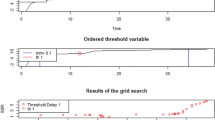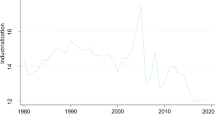Abstract
The impact of foreign direct investment (FDI) on China’s CO\(_{2}\) emissions is an important index to evaluate the effect of foreign investment policy. This paper uses the monthly data of CO\(_{2}\) emissions and FDI from January 1997 to December 2013 to analyze the regime states, switching probability and regime correlation between FDI and CO\(_{2}\) emissions with the help of nonlinear Markov-switching vector error correction model (MS-VECM), The results indicate that the influence of FDI on CO\(_{2}\) emissions shows the two-regime dynamic characteristics, FDI has played a stimulating role in promoting China’s CO\(_{2}\) emissions during the period from January 1997 to October 2003, while played an inhibiting role during the period from November 2003 to December 2013. The duration of the inhibiting effect of FDI on CO\(_{2}\) emissions is longer, and the frequency is higher than that of the stimulating effect. Therefore, the overall influence of FDI on CO\(_{2}\) emissions during the period from January 1997 to December 2013 is inhibitive, which means FDI has contributed to CO\(_{2}\) emissions reduction. The innovation points of this study are mainly reflected in the following two aspects: first, nonlinear MS-VECM is introduced to dynamically study the relationship between FDI and CO\(_{2}\) emissions in contrast to prior studies that simply use static analysis method; second, the effect of China’s foreign investment policies on CO\(_{2}\) emissions is evaluated in each period according to the empirical results of MS-VECM.

Similar content being viewed by others
References
Atici, D. (2012). Carbon dioxide emissions, trade liberalization, and the Japan–ASEAN interaction: A group-wise examination. Journal of Janpanese and International Economies, 26(1), 167–178.
Auffhammer, M., Sun, W., & Wu, J. (2016). The decomposition and dynamics of industrial carbon dioxide emissions for 287 Chinese cities in 1998–2009. Journal of Economic Surveys, 30(3), 460–481.
Cohen, M. A., & Vandenbergh, M. P. (2012). The potential role of carbon labeling in a green economy. Energy Economics, 34(3), 53–63.
Guo, W., Sun, T., & Dai, H. (2016). Effect of pollution structure change on carbon emission in China. Sustainability, 8(3), 225–244.
Hamilton, J. D. (1989). A new approach to the economic analysis of nonstationary time series and the business cycle. Econometrica, 57, 357–384.
Huang, G., Ouyang, X., & Yao, X. (2015). Dynamics of China’s regional carbon dioxide emissions under gradient economic development mode. Ecological Indicators, 51, 197–204.
Jorgenson, A. K. (2007). Financial does foreign investment harm the air we breathe and the water we drink? A cross-national study of carbon dioxide emissions and organic water pollution in less-developed countries, 1975 to 2000. Organization and Environment, 20(2), 137–156.
Kanas, A., & Kouretas, G. P. (2007). Regime dependence between the official and parallel foreign currency markets for US dollars in Greece. Journal of Macroeconomics, 29(2), 431–449.
Kim, C. J., & Nelson, C. (1999). A Bayesian approach to testing for Markov-switching in univariate and dynamic factor models. International Economic Reviews, 42(4), 989–1013.
Knight, K. W., & Schor, J. B. (2014). Economic growth and climate change: A cross-national analysis of territorial and consumption-based carbon dioxide emissions in high-income countries. Sustainability, 6(6), 3722–3731.
Krolzig, H. M. & Wohrmann, D. (1996). Seignorage, government spending and growth in a Lucasian general equilibrium model. University of Oxford Economics Series, Working Papers.
Lee, J. W. (2013). The contribution of foreign direct investment to clean energy use, carbon dioxide emissions and economic growth. Energy Policy, 55(4), 483–489.
Liu, J., & Guo, Q. (2014). Influence of international technology spillover on China’s carbon emissions. Environmental Engineering and Management Journal, 13(5), 1199–1205.
Liu, Y., Xiao, H., & Zhang, N. (2016). Industrial carbon dioxide emissions of China’s region: A spatial econometric analysis. Sustainability, 8(3), 210–223.
Miomir, J., Ljiljana, K., Aleksandra, D., & Vladimir, K. (2015). The impact of agro-economic factors on GHG emissions: Evidence from European developing and advanced economies. Sustainability, 7(12), 16290–16310.
Pan, X., & Yang, Y. (2013). Research on interactive relationship between foreign trade and carbon emission: Based on simultaneous equation model. Operations Research and Management Science, 24(1), 132–137.
Peng, H. F., Tan, X. Y., Li, Y. L., & Hu, L. Q. (2016). Economic growth, foreign direct investment and CO\(_{2}\) emissions in China: A panel Granger causality analysis. Sustainability, 8(3), 233–245.
Ren, A., Yuan, B., Ma, X., & Chen, X. (2014). The impact of international trade on China’s industrial carbon dioxide emissions since its entry into WTO. Energy Policy, 69(3), 624–634.
Song, M., Tao, J., & Wang, S. (2015). FDI, technology spillovers and green innovation in China: Analysis based on data envelopment analysis. Annals of Operations Research, 228(1), 47–64.
Song, M., Wang, S., Jiang, Z., Yang, J., & Wang, Y. (2012). Will environmental logistics be promoted by changing industrial structure? A quantitative analysis from 1978 to 2007 in China. Supply Chain Management, 17(1), 5–14.
Song, M., & Zhou, Y. (2015). Analysis of carbon emissions and their influence factors based on data from Anhui of China. Computational Economics, 46(3), 359–374.
Tang, C. F., & Tan, B. W. (2015). The impact of energy consumption, income and foreign direct investment on carbon dioxide emissions in Vietnam. Energy, 79, 447–454.
Walter, I., & Ugelow, J. L. (1979). Environmental policies in developing countries. Ambio, 8(2/3), 102–109.
Wooldridege, J. M. (2013). Introductory econometrics: A modern approach. Mason: South-Western.
Zhang, Y. (2011). The impact of financial development on carbon emissions: An empirical analysis in China. Energy Policy, 39(4), 2197–2203.
Zhang, N., & Choi, Y. (2013a). Environmental energy efficiency of China’s regional economies: A non-oriented slacks-based measure approach. Social Science Journal, 50(2), 225–234.
Zhang, N., & Choi, Y. (2013b). Total-factor carbon emission performance of fossil fuel power plants in China: A metafrontier non-radial Malmquist index analysis. Energy Economics, 40(2), 549–559.
Zhang, N., Kong, F., Choi, Y., & Zhou, P. (2014). The effect of size-control policy on unified energy and carbon efficiency for Chinese fossil fuel power plants. Energy Policy, 70(4), 193–200.
Zhang, N., & Wei, X. (2015). Dynamic total factor carbon emissions performance changes in the Chinese transportation industry. Applied Energy, 146, 409–420.
Zhang, C., & Zhou, X. (2015). Does foreign direct investment lead to lower CO\(_{2}\) emissions? Evidence from a regional analysis in China. Renewable and Sustainable Energy Reviews, 58, 943–951.
Zhou, M. (2015). Adapting sustainable forest management to climate policy uncertainty: A conceptual framework. Forest Policy & Economics, 59, 66–74
Zhu, H., Duan, L., & Guo, Y. (2016). The effects of FDI, economic growth and energy consumption on carbon dioxide emissions in ASEAN-5: Evidence from panel quantile regression. Economic Model, 58, 237–248.
Acknowledgements
This paper is the stage achievement of National nature science Foundation Project (71734001, 71303029), Liaoning province Social Science Fund Project (L16BJL002). The authors thank for the support of National nature science Foundation and Liaoning province Social Science Foundation. Meanwhile, The authors would like to thank Yaobo Yan for the help in the use of the Markov-switching vector error correction model.
Author information
Authors and Affiliations
Corresponding author
Rights and permissions
About this article
Cite this article
Pan, X., Zhang, J., Li, C. et al. Exploring Dynamic Impact of Foreign Direct Investment on China’s CO\(_{2}\) Emissions Using Markov-Switching Vector Error Correction Model. Comput Econ 52, 1139–1151 (2018). https://doi.org/10.1007/s10614-017-9745-x
Accepted:
Published:
Issue Date:
DOI: https://doi.org/10.1007/s10614-017-9745-x




